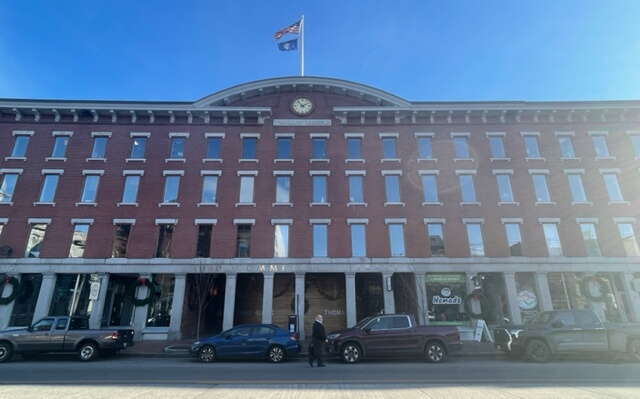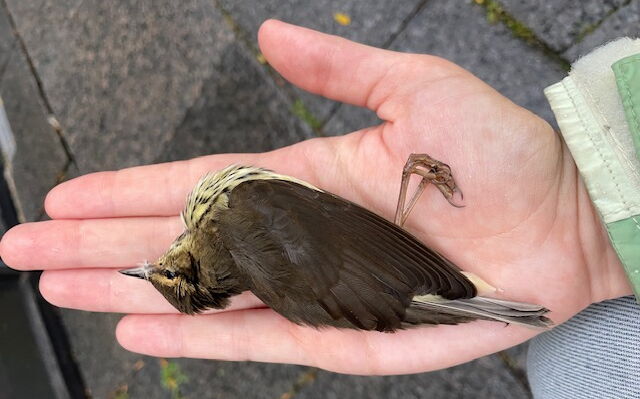
Some new buildings in Portland would have to be bird-safe, under proposed ordinance
 Courtesy / Maine Audubon
Twice-yearly surveys in Portland have found the bodies of birds, including this northern water thrush, believed to have died from building collisions.
Courtesy / Maine Audubon
Twice-yearly surveys in Portland have found the bodies of birds, including this northern water thrush, believed to have died from building collisions.
New buildings in Portland may soon have to accommodate visitors who often go unnoticed until it's too late — birds.
Each year, 40,000 to 50,000 birds die in Portland after striking building windows, according to estimates from Nick Lund, advocacy and outreach manager for Maine Audubon. The City Council's Sustainability and Transportation Committee is now reviewing a draft ordinance that might lessen those numbers.
The proposal, to be discussed at a committee meeting Wednesday afternoon, would mandate the use of bird-friendly materials for new construction over 10,000 square feet in floor area. The requirement would also apply to building additions and to alterations where most of a building's glazing is being replaced.
The ordinance has been in the works for over a year, with input from city staff, council members and BirdSafe Maine, a collaboration of Maine Audubon, the Portland Society for Architecture and the University of Southern Maine.
"Our draft ordinance is a smarter version of similar bills passed in cities like New York City and Washington, D.C.," Lund told Mainebiz. "We've learned what works and what doesn't work from those cities and others, and developed our draft with the help of local architects and designers."
On July 12, the Sustainability and Transportation Committee took up an initial draft of the ordinance. In response to public feedback at that meeting, the draft now exempts residential construction from the requirements.
Bird-friendly windows are more visible to feathered passers-by, who otherwise can fly headlong into glass panes, especially if they are reflective. To minimize that risk, there are products such as adhesive window films and fritted glass, a common material in which a fine powder is fused to glass to create subtle patterns and designs.
Under the ordinance, materials used in a building's exterior would have to score no more than 30 on a 100-point industry scale measuring "maximum threat factor" to birds.
Building for the birds
Troy Moon, the city's sustainability director, noted in a staff memo last week that "there are an increasing number of bird-friendly glass products available on the market" but also that "thoughtful architectural design can reduce the risk to birds without the use of specialized products."
Lund agrees. "The truth is the many (most?) buildings in Portland would meet the requirements of this ordinance without even knowing it," he said in an email. Many historic buildings in Portland are naturally bird-safe since they have small, recessed windows or use antique glass, according to Maine Audubon.
Elsewhere, however, bird-safety ordinances have begun to attract criticism. Cost has been a typical concern.
Lund tried to dispel that. "The experience of other cities is that taking bird safety into account at the design stage means that bird-safe buildings of any kind do not cost more than any other building," he said.
"It's only when a building is built with large glass facades and tenants or employees experience birds dying outside their homes or offices that costs incur for retrofits."

Lund and others have been surveying Portland for three years to estimate the number of birds that die after flying into building facades. Based on the findings, he concluded that "the bird strike problem [is] not exclusive to, but overwhelmingly grouped at, commercial buildings with lots of reflective glass."
A recent study, for example, identified one culprit: a glass-facade building that houses the MEMIC Group, at 261 Commercial St. in Portland. The building's management has since taken steps to make the structure more bird-friendly.
In August, a county judge in Wisconsin rejected what is believed to be the nation's first legal challenge to local bird-safety ordinances. A group of developers represented by the Wisconsin Institute for Law and Liberty sued the city of Madison, arguing its rules — similar to Portland's proposal — went far beyond what was allowed under the Wisconsin state building code.
Judge Nia Trammel ruled the standards actually fall under Madison's zoning code, and so are permitted.
Portland's draft ordinance would have to be referred to the City Council and approved there in order to take effect. The Sustainability and Transportation Committee meets at 5 p.m. Wednesday, and more information can be found here.










0 Comments